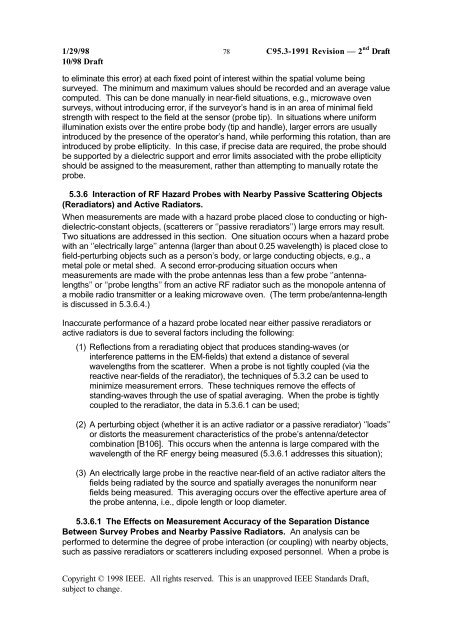DRAFT Recommended Practice for Measurements and ...
DRAFT Recommended Practice for Measurements and ...
DRAFT Recommended Practice for Measurements and ...
Create successful ePaper yourself
Turn your PDF publications into a flip-book with our unique Google optimized e-Paper software.
1/29/98 78 C95.3-1991 Revision — 2 nd Draft<br />
10/98 Draft<br />
to eliminate this error) at each fixed point of interest within the spatial volume being<br />
surveyed. The minimum <strong>and</strong> maximum values should be recorded <strong>and</strong> an average value<br />
computed. This can be done manually in near-field situations, e.g., microwave oven<br />
surveys, without introducing error, if the surveyor’s h<strong>and</strong> is in an area of minimal field<br />
strength with respect to the field at the sensor (probe tip). In situations where uni<strong>for</strong>m<br />
illumination exists over the entire probe body (tip <strong>and</strong> h<strong>and</strong>le), larger errors are usually<br />
introduced by the presence of the operator’s h<strong>and</strong>, while per<strong>for</strong>ming this rotation, than are<br />
introduced by probe ellipticity. In this case, if precise data are required, the probe should<br />
be supported by a dielectric support <strong>and</strong> error limits associated with the probe ellipticity<br />
should be assigned to the measurement, rather than attempting to manually rotate the<br />
probe.<br />
5.3.6 Interaction of RF Hazard Probes with Nearby Passive Scattering Objects<br />
(Reradiators) <strong>and</strong> Active Radiators.<br />
When measurements are made with a hazard probe placed close to conducting or highdielectric-constant<br />
objects, (scatterers or ‘’passive reradiators’’) large errors may result.<br />
Two situations are addressed in this section. One situation occurs when a hazard probe<br />
with an ‘’electrically large’’ antenna (larger than about 0.25 wavelength) is placed close to<br />
field-perturbing objects such as a person’s body, or large conducting objects, e.g., a<br />
metal pole or metal shed. A second error-producing situation occurs when<br />
measurements are made with the probe antennas less than a few probe ‘’antennalengths’’<br />
or ‘’probe lengths’’ from an active RF radiator such as the monopole antenna of<br />
a mobile radio transmitter or a leaking microwave oven. (The term probe/antenna-length<br />
is discussed in 5.3.6.4.)<br />
Inaccurate per<strong>for</strong>mance of a hazard probe located near either passive reradiators or<br />
active radiators is due to several factors including the following:<br />
(1) Reflections from a reradiating object that produces st<strong>and</strong>ing-waves (or<br />
interference patterns in the EM-fields) that extend a distance of several<br />
wavelengths from the scatterer. When a probe is not tightly coupled (via the<br />
reactive near-fields of the reradiator), the techniques of 5.3.2 can be used to<br />
minimize measurement errors. These techniques remove the effects of<br />
st<strong>and</strong>ing-waves through the use of spatial averaging. When the probe is tightly<br />
coupled to the reradiator, the data in 5.3.6.1 can be used;<br />
(2) A perturbing object (whether it is an active radiator or a passive reradiator) ‘’loads’’<br />
or distorts the measurement characteristics of the probe’s antenna/detector<br />
combination [B106]. This occurs when the antenna is large compared with the<br />
wavelength of the RF energy being measured (5.3.6.1 addresses this situation);<br />
(3) An electrically large probe in the reactive near-field of an active radiator alters the<br />
fields being radiated by the source <strong>and</strong> spatially averages the nonuni<strong>for</strong>m near<br />
fields being measured. This averaging occurs over the effective aperture area of<br />
the probe antenna, i.e., dipole length or loop diameter.<br />
5.3.6.1 The Effects on Measurement Accuracy of the Separation Distance<br />
Between Survey Probes <strong>and</strong> Nearby Passive Radiators. An analysis can be<br />
per<strong>for</strong>med to determine the degree of probe interaction (or coupling) with nearby objects,<br />
such as passive reradiators or scatterers including exposed personnel. When a probe is<br />
Copyright © 1998 IEEE. All rights reserved. This is an unapproved IEEE St<strong>and</strong>ards Draft,<br />
subject to change.
















